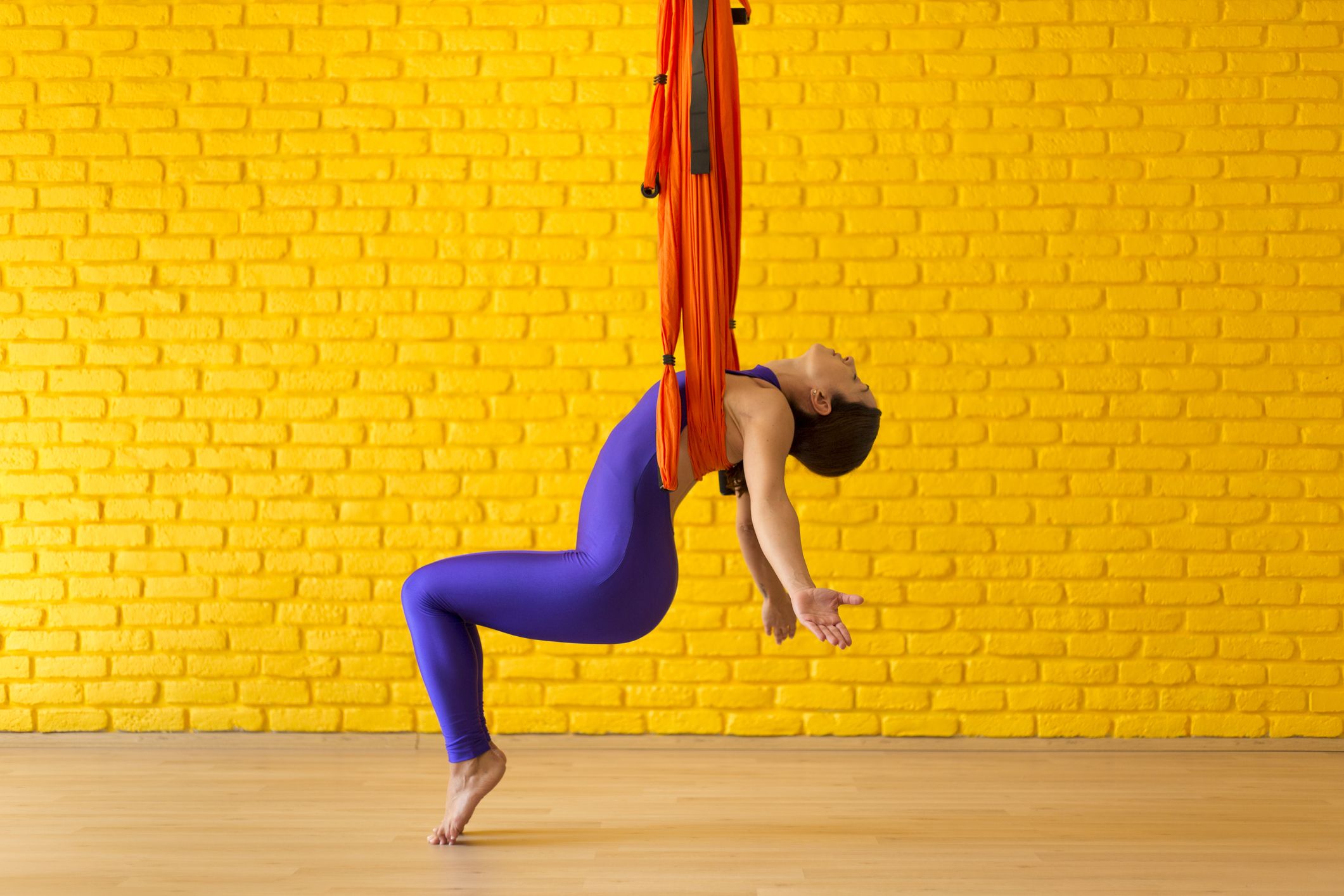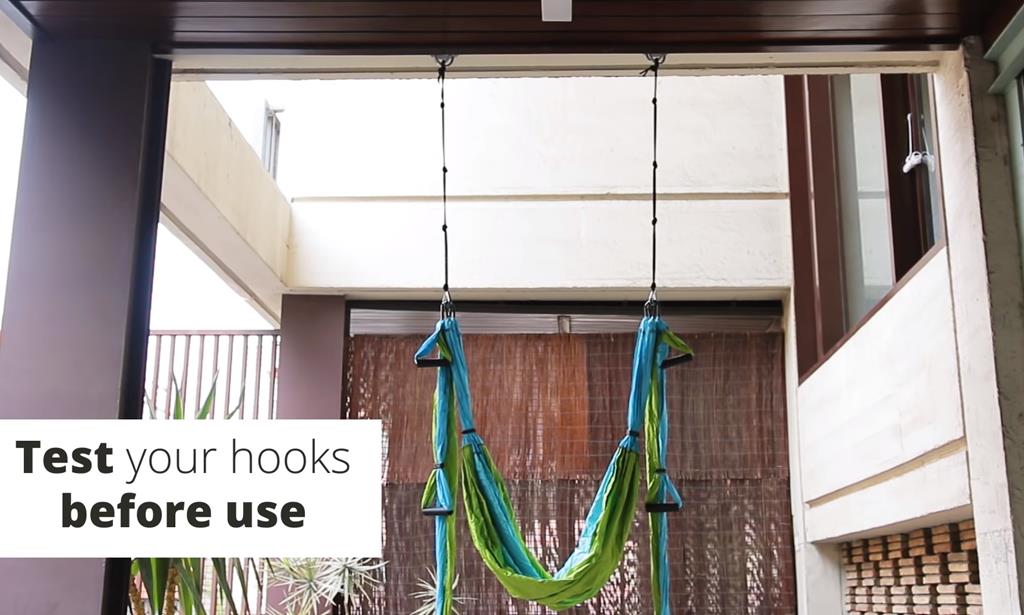Hang your yoga trapeze from a secure beam, bar, or a sturdy tree branch. Ensure the location supports your weight and allows for a free range of motion.
Exploring the dynamic world of yoga, countless enthusiasts seek to elevate their practice through the use of a yoga trapeze. This unique piece of equipment, designed for inversion therapy and aerial yoga poses, requires a thoughtful setup. Practitioners should prioritize safety, seeking strong support structures that can withstand dynamic movement and the user’s full body weight.
Securing your trapeze in an open area not only maximizes the benefits of your yoga sessions but also ensures a safer practice environment. Remember that the right spot will combine both structural integrity and adequate space, allowing you to swing, invert, and stretch without limitations or safety concerns.

Credit: gravotonics.com
Selecting The Ideal Location For Yoga Trapeze
Embarking on the journey of Yoga Trapeze calls for finding that sweet spot that supports safety and serenity. The right locale sets the stage for a rewarding practice.
Indoor Vs Outdoor Placement: Pros And Cons
Choosing where to hang a Yoga Trapeze is the foundation of your aerial practice. Let’s explore inside and outside options.
| Location | Pros | Cons |
|---|---|---|
| Indoor |
|
|
| Outdoor |
|
|
Space Requirements And Ceiling Stability
Space and stability are top considerations. Check these off your list before you install.
- Clear space – Ensure plenty of room around the trapeze. Aim for a buffer zone of at least 3 feet on all sides.
- Strong ceiling – Steady beams or joists are a must. Use a stud finder to locate secure points.
A stable surface is vital for safety. Inspect the selected location carefully to avoid injuries.
Setting Up Indoors: Room Choices And Setup Tips
Creating a tranquil space for a yoga trapeze session at home is key. The right room choice ensures safety and serenity. Useful tips can guide setup, turning a corner of your home into a yoga haven.
Best Rooms For Yoga Trapeze Installation
Choosing the perfect room is vital. It requires space, strength, and tranquility. Consider these:
- Ample Space: Room to sway without hitting walls or furniture.
- Structural Strength: Ceilings must support your weight safely.
- Quiet Area: Less noise helps maintain focus and relaxation.
| Room Type | Pros | Cons |
|---|---|---|
| Spare Bedroom | Privacy and control over the environment. | May need furniture rearrangement. |
| Home Office | Dual-use space, promoting productivity and relaxation. | Workspace distractions. |
| Living Room | Usually larger, more open space. | Household traffic can be disruptive. |
Mounting Methods: Fixed Hooks Vs. Door Mounts
Mounting your yoga trapeze can be done via fixed hooks or door mounts. Compare below:
| Mount Type | Pros | Cons |
|---|---|---|
| Fixed Hooks | Sturdy, permanent solution. | Installation requires drilling, professional help recommended. |
| Door Mounts | Easy, no-drill setup. | Not as secure, limited by door strength. |
When selecting between fixed hooks and door mounts, remember:
- Choose fixed hooks for a long-term, reliable setup.
- Go for door mounts if you prefer an easy and less permanent option.
Always respect weight limits and instructions. Your safety is paramount.
Embracing Nature: Outdoor Yoga Trapeze Setup
When the walls of a studio feel confining, nature offers a boundless stage. Outdoor yoga trapeze setup marries the tranquility of nature with the thrill of aerial yoga. Imagine performing inversions with a backdrop of rustling leaves and open skies.
Trees And Garden Spaces: Natural Mounting Options
Suitable trees become natural stands for your yoga trapeze. Here’s how to find the perfect tree:
- Look for sturdy branches at least 6 inches in diameter.
- Ensure branches are free of diseases or damage.
- Level ground underneath prevents uneven sessions.
No perfect tree? Consider portable stands in garden spaces. They are stable and easy to move.
Weather Considerations: Protection And Durability
Be mindful of the weather. Weatherproofing your setup extends its life. Use these tips:
- Choose water-resistant materials.
- Shelter your trapeze from intense sun or rain.
- Regularly check for wear and tear.

Credit: www.goodhousekeeping.com
Safety First: Ensuring Secure Installation
Ensuring your yoga trapeze is securely installed is vital to practicing safely. Whether you’re swinging into a deep backbend or simply hanging for a gentle inversion, the integrity of your setup holds the key to preventing injury. Let’s look into the steps needed for a secure installation, prioritizing your well-being with each use.
Checking Structural Integrity
Before hanging your yoga trapeze, assess the strength of the potential support structure. You want a beam, branch, or bar that can handle more than just your weight. Incorporate a safety margin to ensure peace of mind during your practice.
- Locate a solid beam or bar that doesn’t exhibit any bending or warping under pressure.
- Use a stud finder for indoor installations to confirm the solidity of your mounting area.
- Confirm with a professional if you’re unsure about the structure’s stability.
Regular Maintenance Checks
Inspect your yoga trapeze and its installation points routinely. Look for any wear and tear that could compromise the equipment’s reliability. Stay on top of maintenance to avoid accidents.
| Action | Frequency |
|---|---|
| Check hooks and carabiners | Before each use |
| Examine the trapeze fabric | Weekly |
| Test the ceiling mount | Monthly |
Safety Precautions
Always keep safety measures at the forefront of your trapeze yoga sessions. Minimize risks to ensure enjoyable and secure practice every time.
- Have a thick mat or padding below the trapeze for cushioning.
- Know your physical limits to avoid over-exertion.
- Never leave the trapeze hanging outdoors in adverse weather.
Accessories And Adjustments For Optimal Use
Yoga enthusiasts everywhere are discovering the joys and benefits of using a yoga trapeze. The right accessories and adjustments are key to making the most of this unique exercise tool. With these enhancements, users can tailor their yoga trapeze to their comfort and skill level. Let’s explore how additional gear and personalized adjustments can elevate the yoga trapeze experience.
Enhancing Comfort With Additional Gear
Feeling comfortable is crucial for an effective yoga trapeze session. Extra padding and the correct installation tools can make all the difference. Here are some top accessories that add comfort and safety:
- Cushioned handles for a softer grip
- Padded seat covers to increase comfort during extended use
- High-quality carabiners and straps for secure hanging
- Spring-loaded ceiling hooks for a more dynamic movement
Adjusting Yoga Trapeze For Personalization And Comfort
A yoga trapeze should fit your body like a glove. Personalization offers a better grip and posture which leads to more effective training.
| Adjustment | Benefit |
|---|---|
| Strap length | Customizes the trapeze height for your needs |
| Handle placement | Adjusts to arm length for optimal reach |
| Seat swing | Allows fine-tuning for comfort and skill level |
Remember to continuously evaluate. As you grow in your practice, find the settings that match your current skill level and comfort desires. A personalized yoga trapeze setup provides the foundation for a rewarding aerial yoga journey.

Credit: www.facebook.com
Frequently Asked Questions For Where To Hang Yoga Trapeze
Can You Hang A Yoga Trapeze Indoors?
Yes, hanging a yoga trapeze indoors is possible. It’s essential to choose a strong support like exposed beams or a load-bearing wall. Ensure the structure can safely support your weight. Professional installation is recommended for safety.
What’s The Optimal Yoga Trapeze Height?
The optimal yoga trapeze height is typically around hip level. This height allows for easier mounting and dismounting. For inversions or specific exercises, adjust the height to suit comfort and safety requirements.
Are Ceiling Mounts For Yoga Trapezes Safe?
Ceiling mounts for yoga trapezes are safe when installed correctly. Use a stud finder to locate ceiling joists and select heavy-duty anchors designed for human weight. Professional installation can help ensure maximum safety and stability.
Can You Set Up A Yoga Trapeze Outside?
Setting up a yoga trapeze outside is feasible. Look for sturdy structures like thick tree branches or a freestanding frame. Check for stability and avoid areas where the trapeze might swing into obstacles.
Conclusion
Choosing the ideal spot for your yoga trapeze enhances your practice significantly. Ensure safety, convenience, and adequate space for an enriching experience. Research, preparation, and a touch of creativity can transform your chosen area into a perfect yoga sanctuary. Start hanging your trapeze with confidence and elevate your yoga journey today.



